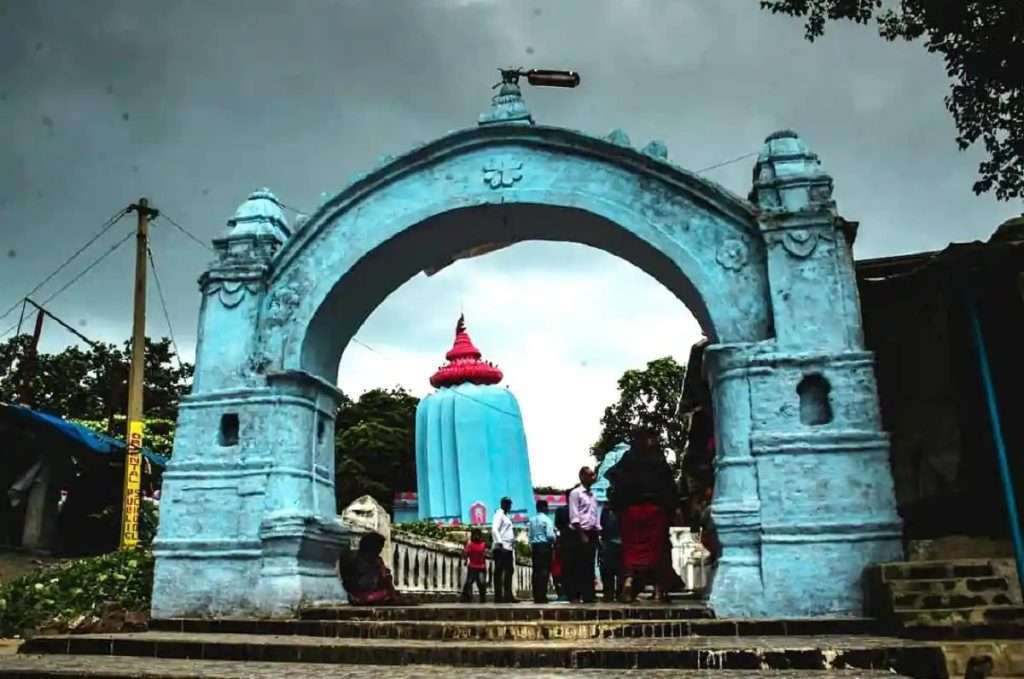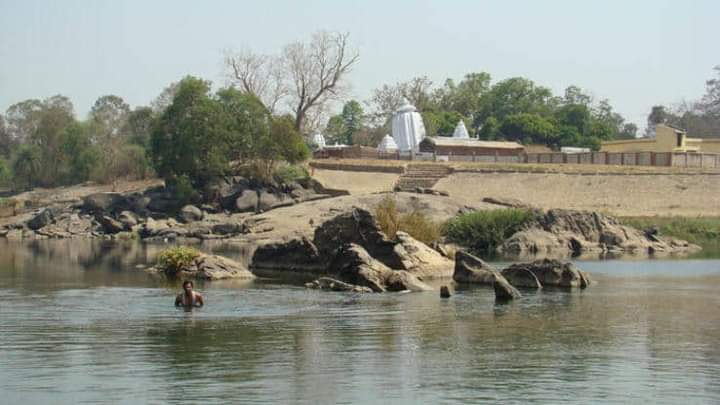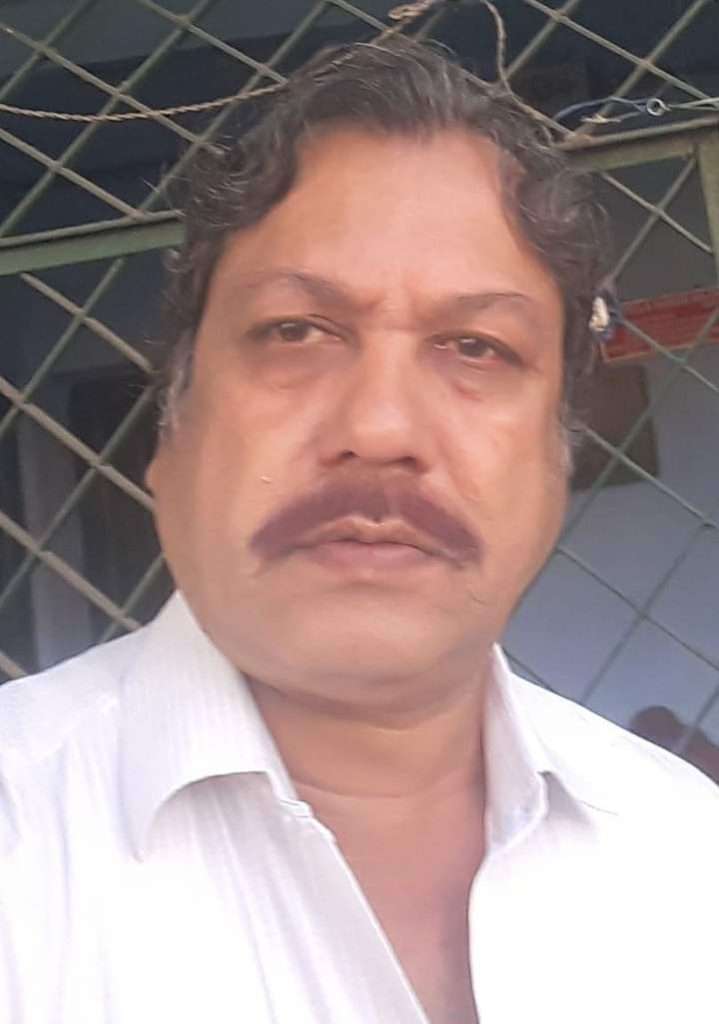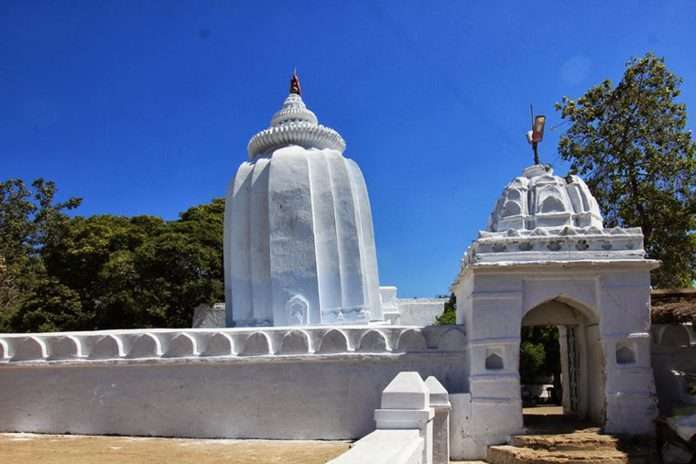Approximately twenty-three kilometers south of the city of Sambalpur, and not very far from the Sambalpur-Sonepur highway, stands the leaning temple of Huma. Dedicated to Baba Bimaleswar Mahadev, the temple is situated on the left bank of the river Mahanadi, at the end of Huma village. From the Sambalpur-Sonepur highway, before Dhama, there is a motorable road up to Huma, and then through the village, one can reach the main gate of the temple. This was the only route earlier. But in recent times, another road has been constructed, which moves just outside the village, reaching out to the temple. Provision has been made for parking of vehicles adjacent to the temple and the Mahanadi flowing by.
The leaning structure of the temple comes into sight the moment one reaches the end of the village where the main entrance stands. Even the boundary of the temple is leaning. It is firmly believed that even if a new structure is erected inside the boundary, it will get a leaning. The temple is unique in the whole of the country and often compared to the leaning tower of Pisa. It is reported that the temple is even more leaning than the tower of Pisa. It is surprising that the main temple and the other temples in the complex are leaning in different directions. Even the newly constructed Jagannath temple inside the temple complex has started tilting as confirmed by a local resident. Its leaning nature makes the temple unique both in India and the world. Different reasons have been cited for its leaning nature:
- Movement in soil structure – The temple has been constructed on one bank of the river Mahanadi, and repeated lashing of river water against the soil has often been cited for its being leaning. Tectonic movement in soil structure underneath the temple is believed to have tilted the main temple and other temples in different directions. The slipping of the rocky bed below the foundation due to floodwaters or an earthquake is another reason in this theory. It is also said that there was some defect at the time of laying the foundation of the temple, and the tilting nature came to sight immediately thereafter. Since no other temple on river banks is leaning its leaning nature remains all the more unique. The soil type found here may be different from others. Thus tectonic movement with a different type of soil over here and a defect with the foundation may very well be accepted as the cause for its leaning nature.
- Natural style of construction – It is believed in certain circles that the temple has been built in a leaning way since its inception. Years back while talking to me, an educated youth of Huma village made it clear that it was a particular style prevalent at the time. He further confirmed that certain other temples of the period in Odisha would appear to be slightly leaning if closely viewed. If this view is accepted, it implies that only this temple has been so built as the other temples built during the Chauhan rulers of Sambalpur do not follow this pattern. The temple conforms to the other characteristics of temple style of architecture of the area and time. This view may have come out from the incident that due to some error at the time of foundation the tilting remained which could not be rectified any further. It is also believed that the masons tried their level best but could not save it from being leaning. Another belief holds that the temple has been built in a tilted condition to protect it from the river water.
- Religious belief – India is a country of strong religious beliefs, and such beliefs are often deep-rooted. Baba Bimaleswar Mahadev of Huma is believed to be very strict with miraculous powers. Before the present temple was built, the Lord was being worshiped in a cottage. A young girl visited it regularly. Once she was affected by greed and took away a small portion of the snake made of metal from the tail side. She continued to do so. When her marriage was fixed, she thought that if she took a major portion of the metal snake it would be helpful to meet her day-to-day expenses in her new abode. At this, the Lord got furious and cursed that whatever structure was built over here would be tilted. The story was narrated by a senior resident of Huma village who made it clear that the Lord is a disciplinarian and cannot tolerate anything wrong. It is also believed that since the Lord had appeared in a tilted position from the beginning, the temple has also become tilted. This view may support the incident of the masons not being able to fathom the tilting nature of the foundation which could be known beforehand. The more they tried to make it straight the more tilting it turned out to be. The flaw of the foundation is also difficult to accept. Temples were being built under the direct supervision of kings who would never allow such a thing to happen. Then there was the fear of heavy royal punishment if anything went wrong.

Another interesting point of the temple is that though it has tilted to an angle of a considerable degree, its top is perpendicular to the earth. Tectonic movement of the riverside soil or change in soil structure under the temple complex has been the most accepted theory regarding the leaning nature of the temple. It is opined by the local people that there has been no change in the inclination of leaning for the last fifty years or so. Though different reasons have been cited, the leaning nature of the temple is still shrouded in mystery. Whatever may be the reason, it has been the main attraction for tourists. Other attractions of the temple are as follows:
1) Scenic backdrop – The temple, situated on one bank of the river Mahanadi at the end of the village Huma, is set against a picturesque backdrop. The river offers a panoramic view, with areas adjacent to the river characterized by a dense water flow. Local boats are available at the temple ghat for visitors.
2) Kudo fish – Kudo fish, a special type found in areas adjacent to the temple ghat, have a unique relationship with devotees. They accept sweets from worshippers and are believed to be dear to the Lord. During the rainy season, they seek shelter inside the temple by entering through a tunnel. According to a senior local resident, they respond when called by names like ‘Sunapindhi’ and ‘Gunapindhi’. Nobody attempts to catch or harm the kudo fish, as it is believed they are an incarnation of Lord Vishnu. According to popular belief, anyone attempting to harm them will turn to stone. Near the temple ghat, there is a statue of a woman in the posture of cutting a fish on a hillock. She is believed to have met her fate while trying to cut a Kudo fish with a ‘panikhi’. This belief has instilled a sense of awe and reverence for the fish among the people. Additionally, there is a Kali temple on this hillock, which devotees visit by boat.
3) Mahasivratri – Mahasivratri is the main festival celebrated at the temple with great pomp and splendor. On this occasion, devotees engage in night-long meditation and worship of the Lord. People from nearby areas as well as far-off places flock to the temple during this time. An ancient fair is held for over a week during Mahasivratri, which serves as a hub for marketing activities for the local community. Along with Mina bazar and hotels, various other materials are available at the fair.
Each religious peetha or place in India is associated with myths or legends, which hold significant importance due to the deep religious sentiments and faith of the people. Although history serves as the main source of information, myths and legends are passed down through generations as hearsay. The Huma Bimaleswar Mahadev temple is associated with several myths and legends:

1) Myth – It is believed that both Lord Shiva and Mata Parvati, enamored by the beauty of western Odisha, settled in Huma as ‘Ashtashambhu’ and ‘Saptachandi’ respectively. Huma is one of the ‘Ashtashambhu Peethas’, primarily found in the districts of Sambalpur and Bargarh, considered an early or ‘Adya Peetha’.
2) Legend – According to legend, a black cow belonging to the Hota Gountia family of Papanga, on the other side of the river Mahanadi, used to pour milk on a spot regularly after crossing the river. Upon discovering this, the Gountia family began worshipping the Lord, and later, the temple is believed to have been built on that spot. Another belief suggests that the temple was constructed overnight by Lord Viswakarma. When the cow returned to pour milk the next morning, she couldn’t find the Linga and started crying. From her sound ‘Humma’, the name Huma is believed to have originated.
3) According to another popular belief, in the early thirteenth century, King Anangabhimadev III of Puri visited Huma to worship the Lord in order to cure himself of leprosy. It is believed that the first temple here was built by him and later rebuilt by King Baliar Singh Dev of Sambalpur. Historians also mention this incident occasionally. Balaram Dev, the first Chauhan king of Sambalpur, is also credited with building the temple, which was later rebuilt by King Baliar Singh Dev, the fifth ruler in the lineage. The remaining ‘Ashtashambhu’ temples in western Odisha were built during the reigns of Ajit Singh and Abhaya Singh, as per historical records.
4) Legend – It is said that King Baliar Singh Dev, the Chauhan king of Sambalpur, came to know about the existence of Lord Shiva in eight places as ‘Ashtashambhu’ through a dream of his minor son. He then ordered the construction of eight temples on these spots. It is believed that the temples were founded on the same day, and the king traveled from one place to another on horseback.
A close study of history, along with myths and legends, reveals the presence of the Lord at Huma as early as the thirteenth century, and even earlier before King Baliar Singh Dev built the present temple. It is considered the earliest or ‘Adya Peetha’ among the eight shrines or ‘Ashtashambhus’ of western Odisha, serving as a place of pilgrimage. Myths, legends, and popular beliefs hold a special place in Indian tradition and may provide valuable insights for historians and researchers, despite being passed down through generations as hearsay. The leaning temple of Huma, which has been recently beautified and developed, remains a major tourist attraction in the district of Sambalpur, drawing devotees and tourists from nearby as well as far-off places throughout the year.
(The views expressed are the writer’s own)

Mr. Prafulla Kumar Majhi,
Retired Asst. Director, A. I. R, is an eminent Scholar and freelance writer in English & Odia. His areas of interests are sociocultural, economic, literary, historical and analytical studies and writings.

